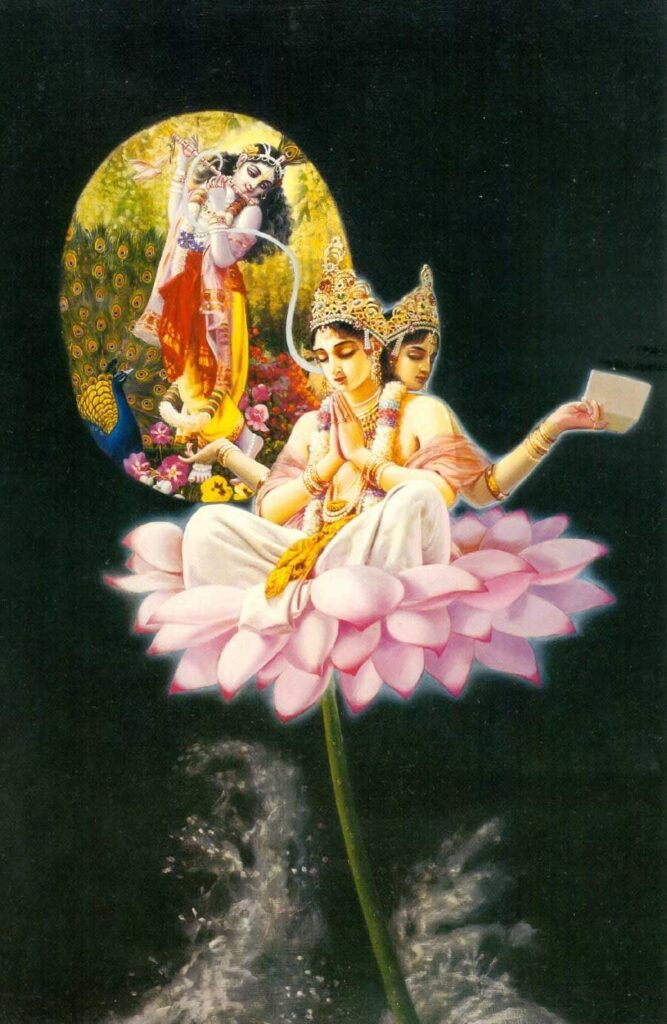In the Srimad Bhagavatam 2.9, it is described how Brahma met the Lord in his original form as Krsna and was instructed in the four seed-verses of the Srimad Bhagavatam, known as the catuh-sloki. One could question when this conversation of Lord Brahma with Krsna happened.
This is actually a difficult question to answer because the focus of the Srimad Bhagavatam is the spiritual instructions and not the historical descriptions. We are currently on the first day of the second half of the life of Brahma. This conversation happened at the very beginning of one of his days, but each one?

In SB 3.4.13, Krsna describes to Uddhava that He spoke to Brahma at the beginning of creation, at the Padma Kalpa (the lotus millennium): purā mayā proktam ajāya nābhye padme niṣaṇṇāya mamādi-sarge, “O Uddhava, in the lotus millennium in the days of yore, at the beginning of the creation, I spoke unto Brahmā, who is situated on the lotus that grows out of My navel”
The different days of Brahma receive names, and two kalpas are referred to as the Padma Kalpa. The first is the second day of the first half of his life, as described in SB 3.11.35-36:
“In the beginning of the first half of Brahmā’s life, there was a millennium called Brāhma-kalpa, wherein Lord Brahmā appeared. The birth of the Vedas was simultaneous with Brahmā’s birth. The millennium which followed the first Brāhma millennium is known as the Pādma-kalpa because in that millennium the universal lotus flower grew out of the navel reservoir of water of the Personality of Godhead, Hari.”
The second is the current day of Brahma. It’s also called Padma because in this millennium the lotus flower also appears, following the complete devastation at the end of the first half of Brahma’s life. The current day is also referred to as the Varāha-kalpa and the Śvetavarāha-kalpa, which can be confusing. However, on SB 2.10.47 Prabhupada makes it clear:
“The present duration of a kalpa of Brahmā is called the Varāha-kalpa or Śvetavarāha-kalpa because the incarnation of the Lord as Varāha took place during the creation of Brahmā, who was born on the lotus coming out of the abdomen of Viṣṇu. Therefore this Varāha-kalpa is also called Pādma-kalpa, and this is testified by ācāryas like Jīva Gosvāmī as well as Viśvanātha Cakravartī Ṭhākura in pursuance of the first commentator, Svāmī Śrīdhara. So there is no contradiction between the Varāha and the Pādma-kalpa of Brahmā.”
As described in the same verse, the events described in the 3rd canto of the Srimad Bhagavatam onwards happened in the current day of Brahma, the Padma Kalpa. The conversation between Brahma and Krsna could thus have happened at the beginning of the current day, or in the previous Padma Kalpa, at the beginning of Brahma’s life.
However, in the Krsna Sandharbha, section 64, Srila Jiva Goswami quotes a verse from the Gopala Tapani Upanisad (1.27): tad u hovaca brāhmaṇaḥ asāv anavaratam me dhyātaḥ stutaḥ parārdhante so ‘budhyata. gopa-vešo me purastād āvirbabhūva.
“Brahmā replied, “O brāhmaņas, during the first half of my life, I meditated upon Him and praised Him constantly. Then at the end of a parārdha, that Supreme Puruşa awoke and appeared before me as a cowherd boy.”
In this verse, Lord Brahma speaks to the Kumaras. It suggests that Krsna appeared to him after the end of the first half of his life (parārdhante). Since we are on the first day of the second half of his life, this would put the meeting at the beginning of the current day, which is also known as the Padma-Kalpa.
If this version is accepted, then the chronology of the Srimad Bhagavatam would be that Brahma had the view of the Lord and received the catuh-sloke Srimad Bhagavatam from Him (described in the 9th chapter of the 2nd canto) at the very beginning of the current day. Brahma then transmitted this knowledge to Narada Muni, who transmitted it to Vyasadeva. VYasadevva then expanded this knowledge and spoke it to Sukadeva Goswami, who expanded it further in his description to Maharaja Pariksit.
